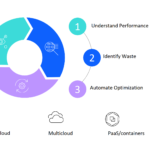Cloud & Infrastructure
We redefine what data can do for you with our cloud & infrastructure services.
Cresco partners with technologies that provide a cloud platform characterized by security, flexibility, and scalability, ensuring enterprise-level security and compliance. With proactive support and monitoring, it enables businesses to prioritize their core operations.
Red Hat Enterprise Linux
The world’s leading enterprise Linux platform, providing a stable, secure, and scalable foundation for modern applications.
OpenShift
Our Kubernetes platform offers automated operations to manage hybrid cloud, multi-cloud, and edge deployments.
Ansible
Automate your IT infrastructure, from apps to security, with simplicity and power.
Cloud Services
Optimize Cloud Costs
Contain cost while preserving performance with automatic, continuous cloud optimization.
Infrastructure Observability
Full-stack visibility, automatic application mapping and monitoring.
Technologies we Support
Interested in Storage?
Our Business Partners in Cloud
Technologies we Support
Buy Cloud Credits from
Resources
Monitoring Microservices
Watch this video to learn a bit about what Instana does, how Instana works, and how much it all costs
IBM Turbonomic
Turbonomic leaders speak on the technology’s inception, use cases, and differentiation.
What is Data Lineage?
Learn more about the importance of understanding and tracking the lineage of data.
Use Cases

GameStop
To run a major international retail business effectively, data-driven decision-making is a must. Through BI tools such as IBM® Cognos® Analytics, GameStop is empowering business users to serve themselves with the data they need and transforming the IT team from a producer of reports to an enabler of business insight.

Melbourne Water
To reduce the need for onsite crews to inspect 4,000 stormwater pit grates over a 14,000 sq km region, Melbourne Water used IBM Maximo IoT solutions and IBM Cloud to automate drain inspection, with the goal of achieving significant time and cost savings.

Lufthansa Group
IBM Services delivers a flexible and scalable managed cloud solution for Lufthansa.com that ensures a consistent, app-like user experience and delivers content based on user interest.

Pandora Jewllery
To personalize the digital experience, Pandora Jewellery created an e-commerce platform powered by Salesforce and IBM Sterling Order Management on Cloud. The platform efficiently handled double the previous year’s e-commerce volume.
Featured Blogs

Introducing IBM Turbonomic – The Key to Autonomous Hybrid Cloud Optimization
FAQs
A cloud strategy is a comprehensive plan that outlines how an organization will leverage cloud computing technologies to achieve its business objectives. It encompasses the adoption, migration, and management of cloud services to enhance agility, scalability, cost-effectiveness, and innovation.
A cloud strategy is important because it helps organizations harness the benefits of cloud computing while effectively managing risks and maximizing return on investment. It enables organizations to modernize their IT infrastructure, improve operational efficiency, foster innovation, and adapt to changing business needs more rapidly.
Key components of a cloud strategy typically include:
- Business objectives: Clear articulation of the organization’s goals and objectives that drive cloud adoption, such as improving agility, reducing costs, or enabling innovation.
- Cloud adoption approach: Strategy for selecting and prioritizing workloads and applications for migration to the cloud, considering factors such as complexity, risk, and business value.
- Cloud deployment models: Decision on the appropriate cloud deployment models (public, private, hybrid) based on organizational requirements, security, compliance, and data sovereignty considerations.
- Cloud architecture: Design and architecture principles for building cloud-native applications and infrastructure, ensuring scalability, reliability, and performance.
- Governance and security: Policies, processes, and controls for managing cloud resources, ensuring compliance with regulations, and mitigating security risks.
- Cost management: Strategies for optimizing cloud costs, monitoring usage, and implementing cost controls to maximize cost-effectiveness and return on investment.
- Integration and interoperability: Approach for integrating cloud services with existing IT systems and applications, ensuring seamless data exchange and interoperability.
- Skills and talent development: Plans for acquiring, developing, and retaining the necessary skills and talent to support cloud adoption and operations effectively.
Developing a cloud strategy involves several steps:
- Assess current state: Evaluate existing IT infrastructure, applications, and workloads to understand their suitability for cloud migration and identify areas for improvement.
- Define objectives: Align cloud strategy with the organization’s overall business objectives, identifying key drivers and priorities for cloud adoption.
- Conduct a cloud readiness assessment: Assess organizational readiness for cloud adoption, considering factors such as skills, culture, governance, and technology maturity.
- Develop migration plan: Develop a phased migration plan that prioritizes workloads, defines migration approaches, and establishes timelines and success criteria.
- Define governance and security framework: Establish policies, processes, and controls for managing cloud resources, ensuring compliance, and mitigating security risks.
- Determine cloud architecture: Design cloud architecture principles and best practices that align with organizational goals, ensuring scalability, reliability, and performance.
- Implement cost management strategies: Implement tools and processes for monitoring and optimizing cloud costs, establishing cost controls, and maximizing return on investment.
- Build skills and capabilities: Invest in training and talent development to ensure that the organization has the necessary skills and capabilities to support cloud adoption and operations effectively.
- Develop a communication plan: Communicate the cloud strategy and its benefits to stakeholders, fostering buy-in and alignment across the organization.
Successful implementation of a cloud strategy requires:
- Executive sponsorship: Strong support and involvement from executive leadership to prioritize and champion cloud initiatives, providing resources and removing barriers to adoption.
- Cross-functional collaboration: Collaboration across departments and stakeholders to ensure alignment of cloud initiatives with business objectives, fostering a culture of collaboration and accountability.
- Change management: Effective communication and training to prepare employees for the changes associated with cloud adoption, addressing concerns and promoting adoption.
- Performance monitoring and optimization: Continuous monitoring of cloud performance, costs, and security, implementing optimizations and improvements based on insights and feedback.
- Compliance and risk management: Regular assessment of compliance with regulations and industry standards, implementing controls and measures to mitigate risks associated with cloud adoption.
- Vendor management: Effective management of cloud service providers and vendors, ensuring adherence to service level agreements, managing relationships, and optimizing costs.
- Continuous improvement: Regular review and refinement of the cloud strategy and implementation approach based on lessons learned, feedback, and evolving business needs and technology trends.
A cloud migration strategy is a plan that outlines how an organization will transition its applications, data, and workloads from on-premises infrastructure to cloud-based environments. It involves selecting the appropriate migration approach, assessing and prioritizing workloads, and implementing migration activities to achieve business objectives efficiently and effectively.
A cloud migration strategy is important because it helps organizations minimize risks, reduce costs, and maximize the benefits of moving to the cloud. It provides a structured approach for planning and executing the migration process, ensuring that applications and workloads are migrated successfully while maintaining performance, security, and compliance requirements.
Key components of a cloud migration strategy typically include:
- Assessment and planning: Evaluation of current infrastructure, applications, and workloads to determine their suitability for migration, identify dependencies, and prioritize migration candidates.
- Migration approach: Selection of the appropriate migration approach based on factors such as workload complexity, criticality, and business requirements, such as rehosting (lift and shift), re-platforming, or rearchitecting.
- Target cloud environment: Decision on the target cloud platform(s) and deployment model(s) (public, private, hybrid) based on organizational requirements, technical capabilities, and cost considerations.
- Migration plan: Development of a detailed migration plan that outlines timelines, milestones, resource requirements, and dependencies for each workload or application being migrated.
- Data migration strategy: Strategy for migrating data to the cloud, including data transfer methods, data synchronization, and data integrity validation, while minimizing downtime and ensuring data consistency.
- Testing and validation: Execution of testing and validation procedures to ensure that migrated applications and workloads meet performance, security, and compliance requirements in the cloud environment.
- Governance and risk management: Implementation of governance processes, policies, and controls to manage risks associated with migration, such as data security, compliance, and performance issues.
- Training and change management: Training programs and change management initiatives to prepare employees for the transition to cloud-based environments, addressing skill gaps and fostering adoption.
- Monitoring and optimization: Implementation of monitoring tools and processes to track the performance, availability, and cost of migrated workloads, enabling optimization and continuous improvement.
Developing a cloud migration strategy involves several steps:
- Assess current state: Evaluate existing infrastructure, applications, and workloads to understand their architecture, dependencies, and performance characteristics.
- Define objectives: Define clear business objectives and goals for cloud migration, aligning them with the organization’s overall strategy and priorities.
- Assess readiness: Assess organizational readiness for cloud migration, including factors such as skills, culture, governance, and technology maturity.
- Select migration approach: Select the appropriate migration approach (lift and shift, re-platforming, rearchitecting) based on workload characteristics, business requirements, and technical considerations.
- Prioritize workloads: Prioritize workloads and applications for migration based on criteria such as business value, complexity, risk, and dependencies.
- Develop migration plan: Develop a detailed migration plan that outlines activities, timelines, resource requirements, and dependencies for each workload or application being migrated.
- Execute migration: Execute migration activities according to the migration plan, including data migration, application migration, testing, validation, and cutover to the cloud environment.
- Monitor and optimize: Monitor the performance, availability, and cost of migrated workloads in the cloud environment, implementing optimizations and improvements as needed to achieve desired outcomes.
- Govern and manage risks: Implement governance processes, policies, and controls to manage risks associated with migration, such as data security, compliance, and performance issues.
- Communicate and train: Communicate progress, updates, and changes related to cloud migration to stakeholders, and provide training and support to prepare employees for the transition to cloud-based environments.
Successful implementation of a cloud migration strategy requires:
- Executive sponsorship: Strong support and involvement from executive leadership to prioritize and champion cloud migration initiatives, providing resources and removing barriers to adoption.
- Cross-functional collaboration: Collaboration across departments and stakeholders to ensure alignment of cloud migration activities with business objectives, fostering a culture of collaboration and accountability.
- Change management: Effective communication and training to prepare employees for the changes associated with cloud migration, addressing concerns and promoting adoption.
- Performance monitoring and optimization: Continuous monitoring of migrated workloads’ performance, availability, and cost, implementing optimizations and improvements based on insights and feedback.
- Compliance and risk management: Regular assessment of compliance with regulations and industry standards, implementing controls and measures to mitigate risks associated with cloud migration.
- Vendor management: Effective management of cloud service providers and vendors, ensuring adherence to service level agreements, managing relationships, and optimizing costs.
- Continuous improvement: Regular review and refinement of the cloud migration strategy and implementation approach based on lessons learned, feedback, and evolving business needs and technology trends.
- Assessment and Planning:
- Conduct a thorough assessment of your current IT infrastructure, applications, and workloads.
- Prioritize workloads based on factors like business criticality, complexity, and dependencies.
- Develop a detailed migration plan with clear objectives, timelines, and resource requirements.
- Select the Right Migration Approach:
- Choose the appropriate migration approach based on workload characteristics and business requirements.
- Consider options like lift and shift (rehosting), re-platforming, or rearchitecting to optimize performance and cost.
- Optimize Workloads for the Cloud:
- Modernize applications and architectures to leverage cloud-native features and capabilities.
- Implement scalability, resilience, and cost optimization best practices in cloud environments.
- Data Migration Strategy:
- Develop a comprehensive data migration strategy to ensure seamless and secure transfer of data to the cloud.
- Use tools and techniques to minimize downtime and ensure data consistency during migration.
- Security and Compliance:
- Implement robust security controls and compliance measures to protect data and applications in the cloud.
- Use encryption, identity and access management (IAM), and other security best practices to secure cloud environments.
- Performance Optimization:
- Monitor and optimize the performance of migrated workloads to ensure they meet performance objectives.
- Use cloud-native monitoring and optimization tools to identify and address performance bottlenecks.
- Cost Management:
- Implement cost management strategies to optimize cloud spending and maximize return on investment (ROI).
- Use cost monitoring tools, reserved instances, and auto-scaling to manage costs effectively.
- Training and Skill Development:
- Provide training and support to IT staff to build cloud migration skills and capabilities.
- Foster a culture of continuous learning and improvement to adapt to evolving cloud technologies.
- Testing and Validation:
- Conduct thorough testing and validation of migrated workloads to ensure they meet performance, security, and compliance requirements.
- Use automated testing tools and methodologies to streamline testing processes.
- Governance and Management:
- Establish governance policies and controls to manage cloud resources effectively and ensure compliance with organizational policies and regulations.
- Implement cloud management tools and practices to monitor, track, and optimize cloud resources.
- Communication and Stakeholder Engagement:
- Communicate with stakeholders regularly to keep them informed about the progress and status of cloud migration initiatives.
- Address concerns and issues promptly to maintain stakeholder confidence and support.
- Backup and Disaster Recovery:
- Implement backup and disaster recovery solutions to ensure data resilience and business continuity in the cloud.
- Test backup and recovery processes regularly to verify their effectiveness and reliability.




